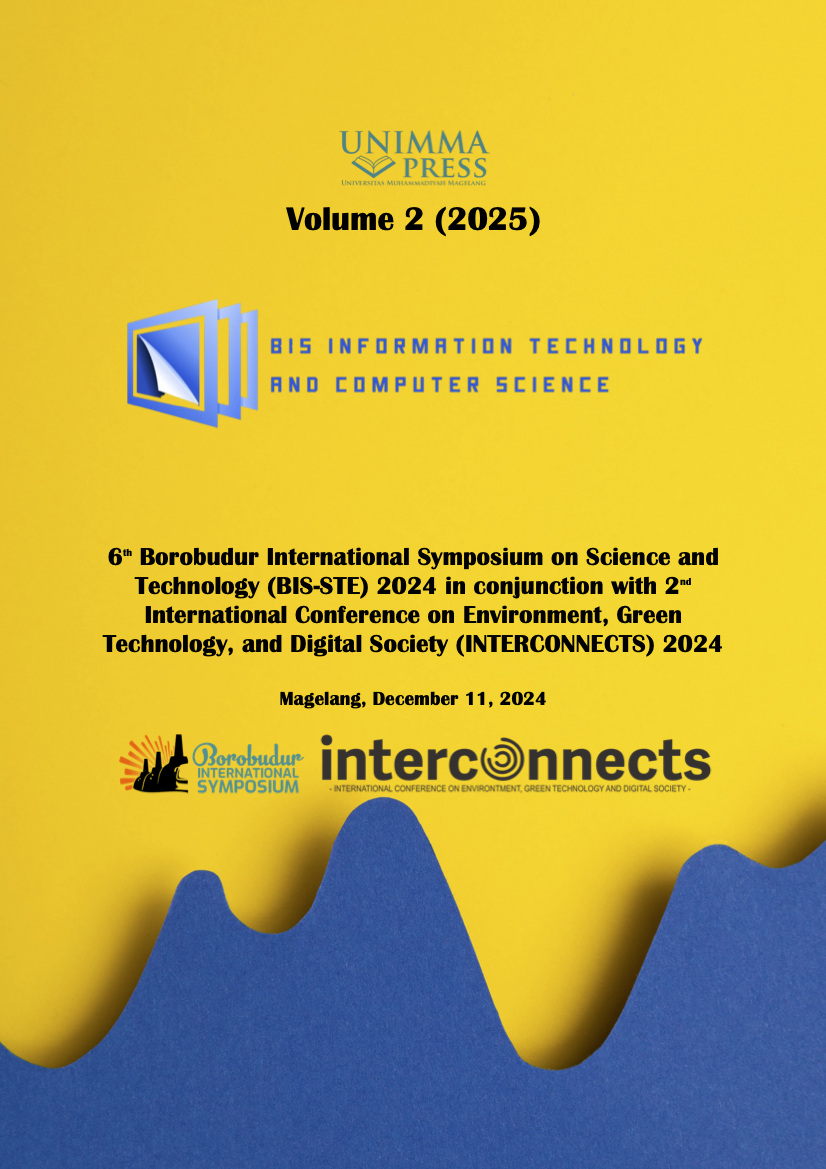IoT-based soil condition monitoring for efficient pakcoy watering system
Keywords:
Pakcoy, Monitoring system, IoT-based, Rapid application development, GreenhouseAbstract
Pakcoy is one of the most popular vegetables in Indonesia due to its nutritional value and its wider stems and leaves compared to regular mustard greens. However, the growing demand for pakcoy has not been effectively met due to declining soil fertility, excessive use of chemical fertilizers, and suboptimal farming techniques. This research proposes a solution to overcome these problems by developing an IoT-based soil condition monitoring system for watering and fertilization. The Rapid Application Development (RAD) method consisting of Requirements Phase, Design Workshop, and Implementation is used to design and implement the system. The system uses an Arduino ESP8266 microcontroller integrated with a soil moisture sensor, DHT11 temperature sensor, and pH sensor to monitor plant conditions. Data is collected and sent to the server every 10 seconds and displayed to the monitoring system. The system automatically regulates watering and fertilization to ensure optimal soil moisture and pH levels. Field testing in a greenhouse by comparing pak coy plants with the traditional way and with the IoT-based system. The results showed significant improvements in plant health, reduced susceptibility to pests, and increased leaf width, with an average increase from 1.8 cm (traditional) to 2.4 cm (IoT-based). This research demonstrates the potential of IoT technology to improve pakcoy farming efficiency, yield quality, and sustainability.
References
[1] B. P. T. Anjani, Bambang Budi Santoso, and Sumarjan, “Pertumbuhan Dan Hasil Sawi Pakcoy (Brassica rapa L.) Sistem Tanam Wadah Pada Berbagai Dosis Pupuk Kascing,” Jurnal Ilmiah Mahasiswa Agrokomplek, vol. 1, no. 1, pp. 1–9, Jun. 2022, doi: 10.29303/jima.v1i1.1091.
[2] B. P. S. Indonesia, “Produksi Tanaman Sayuran - Tabel Statistik.” Accessed: Dec. 30, 2024. [Online]. Available: https://www.bps.go.id/id/statistics-table/2/NjEjMg==/produksi-tanaman-sayuran.html
[3] W. Aji Saputra, “Agroekotek View Pengaruh Berbagai Merek Pupuk Organik terhadap Pertumbuhan dan Produksi Pakcoy pada Lahan Kering Masam,” 2022.
[4] M. Kevin Novan and G. Setyawan, “Rancang Bangun Sistem Pengontrol Kelembapan Tanaman Sawi,” Jurnal Otomasi, Kontrol & Instrumentasi, vol. 13, no. 2, pp. 101–108, 2021.
[5] S. Nurhasanah, A. Komariah, R. Assafaat, and K. Rakhmi, “Respon Pertumbuhan Dan Hasil Tanaman Pakcoy (Brassica rapa L.) Varietas Flamingo Akibat Perlakuan Macam Media Tanam Dan Konsentrasi Pupuk Pelengkap Cair Bayfolan,” Jurnal Inovasi Penelitian, vol. 2, no. 3, pp. 949–954, 2021.
[6] M. Darmawan, A. Khairun Mutia, and Tuti Handayani Arifin, “Pertumbuhan dan Produksi Tanaman Pakcoy (Brassica rapa) dengan Sistem Hidroponik dalam Ember Pemeliharaan Ikan Lele (Clarias): Growth and Production of Pakcoy (Brassica rapa) Plants with Hydroponic Systems in Catfish Rearing Buckets (Clarias),” Perbal, vol. 11, no. 2, pp. 133–141, Jul. 2023, doi: 10.30605/perbal.v11i2.2613.
[7] A. Sugianto, A. Sholihah, and S. Muslikah, “The using of different hydroponic methods on the growth and yield of two pakcoy varieties ( Barissca rapa L. ),” BIO Web Conf., vol. 143, p. 01005, 2024, doi: 10.1051/bioconf/202414301005.
[8] B. Juniarti, S. Ritawati, K. Roidelindho, and A. A. Fatmawaty, “PENGARUH JENIS SUMBU DAN MEDIA TANAM TERHADAP PERTUMBUHAN DAN HASIL TANAMAN PAKCOY (Brassica rapa subsp. L) VARIETAS MASBRO SECARA HIDROPONIK SISTEM WICK,” Agroteksos, vol. 34, no. 2, p. 392, Aug. 2024, doi: 10.29303/agroteksos.v34i2.1122.
[9] M. Rifqi, M. Sasmi, and M. Mashadi, “USAHATANI PAKCOY SISTEM HIDROPONIK DALAM MENINGKATKAN PENDAPATAN PETANI,” agribisnis, vol. 12, no. 2, pp. 111–121, Nov. 2023, doi: 10.32520/agribisnis.v12i2.2810.
[10] Yanti Grace Hutasoit and Yanda Bara Kusuma, “Optimalisasi Pemanfaatan Otomasi Greenhouse Dan Hydroponic Dalam Meningkatkan Produksi Dan Keberhasilan Terhadap Pertanian Budidaya Pakcoy Di PT Inamas Sintesis Teknologi,” jkpu-nalanda, vol. 1, no. 2, pp. 76–86, Jun. 2023, doi: 10.47861/jkpu-nalanda.v1i2.285.
[11] S. Yosep, “Implementation of Fuzzy Logic on Internet of Things-Based Greenhouse,” IOTA, vol. 1, no. 2, pp. 100–113, May 2021, doi: 10.31763/iota.v1i2.489.
[12] Universitas Timor et al., “RANCANG BANGUN SMART GREENHOUSE UNTUK BUDIDAYA TANAMAN SAWI PAKCOY (brassica rapa subsp) BERBASIS ANDROID,” jmika, vol. 7, no. 1, pp. 112–117, Apr. 2023, doi: 10.46880/jmika.Vol7No1.pp112-117.
[13] R. Gunawan, T. Andhika, . S., and F. Hibatulloh, “Monitoring System for Soil Moisture, Temperature, pH and Automatic Watering of Tomato Plants Based on Internet of Things,” Telekontran : Jurnal Ilmiah Telekomunikasi, Kendali dan Elektronika Terapan, vol. 7, no. 1, pp. 66–78, Apr. 2019, doi: 10.34010/telekontran.v7i1.1640.
Downloads
Published
Conference Proceedings Volume
Section
License

This work is licensed under a Creative Commons Attribution-NonCommercial 4.0 International License.

